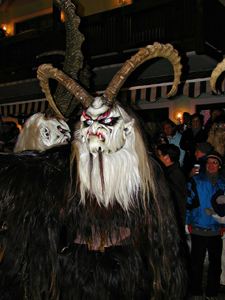21st of December
Perchtentanz – Walk and dance of the Perchten
 by Sabine
by Sabine
I come from the very south of Germany, from the Alps. There the Christmas season is not only peaceful and I am not sure whether I miss this
custom or am happy to be rid of it - the walk and dance of the Perchten.
 According to the belief, beginning from the night of St. Thomas on 21 December until the night from 5 to 6 January, the 12 so called rough
nights (Rauhnächte), the darkest nights of the year, take place. In this time between the years the doors to the spirit realm are opened.
The spirits and the souls of the dead have their exit. Demons can organise processions or go on a wild hunt through the country. Stable
animals are said to speak human language at midnight and tell about the future. And the worst thing: People who hear these animals speak
do not have much use for it, because they die immediately afterwards.
According to the belief, beginning from the night of St. Thomas on 21 December until the night from 5 to 6 January, the 12 so called rough
nights (Rauhnächte), the darkest nights of the year, take place. In this time between the years the doors to the spirit realm are opened.
The spirits and the souls of the dead have their exit. Demons can organise processions or go on a wild hunt through the country. Stable
animals are said to speak human language at midnight and tell about the future. And the worst thing: People who hear these animals speak
do not have much use for it, because they die immediately afterwards.

Perchten appear on the rough nights to monitor nutrition, cleanliness and working conditions during these days. Wrapped in furs and skins,
armed with bells and usually with dark (animal) masks on their heads, they roam noisily through the streets.
Until today in the Alp regions there are several events during these 12 nights when the Perchten walk and dance through the streets.
The most important Perchten are:
 Mrs Percht
Mrs Percht
Mrs. Percht has a Janus-faced appearance: the central figure of the Perchten runs is the sun in the front and the devil in the back. Some
interpret her as the personification of the Nordic goddess Frigg (wife of Odin and patron saint of marriage) or the Germanic goddess Freya
(goddess of fertility), so the origin of the figure is disputed.
Devil
The central motif of the Perchten custom is the duality of day and night, life and death, good and evil. This duality is symbolised by Mrs.
Percht and by jointly appearing, opposing characters. The devil is by far the most "schiachste" (ugliest) Percht. His task is to drive the
girls into the arms of the Schönperchten (nice Perchten).
Schönpercht
Schönperchten mostly stand for life, light and order. They often accompany the Musikperchten (musicians) and make no less noise than the latter.
They also symbolise spring, fertility and warmth.
Musicians
According to tradition, drums, cowbells and wind instruments are used to drive out evil spirits and winter. The Perchten differ greatly in appearance,
but all have a bell.
Dancers
With the dance the evil is to be driven out and the good bound. The dancers jump, whirl and sweep through the streets. The centre of her dance circle
is usually Mrs Percht.
Schlenzer
"Schlenzer" and Schnabelperchten are closely related. The "Schlenzer" frighten and annoy spectators, collect money or try to steal objects.